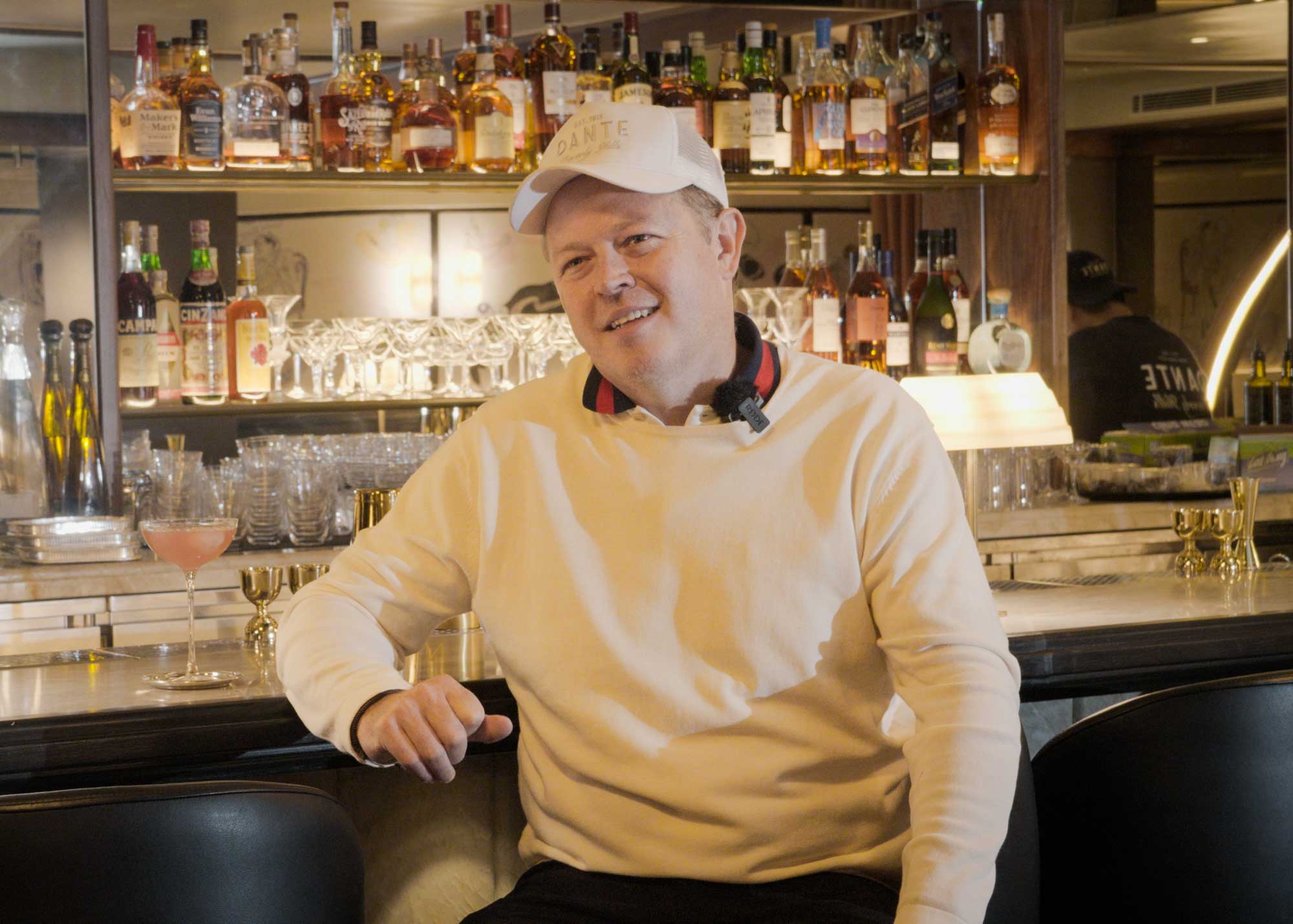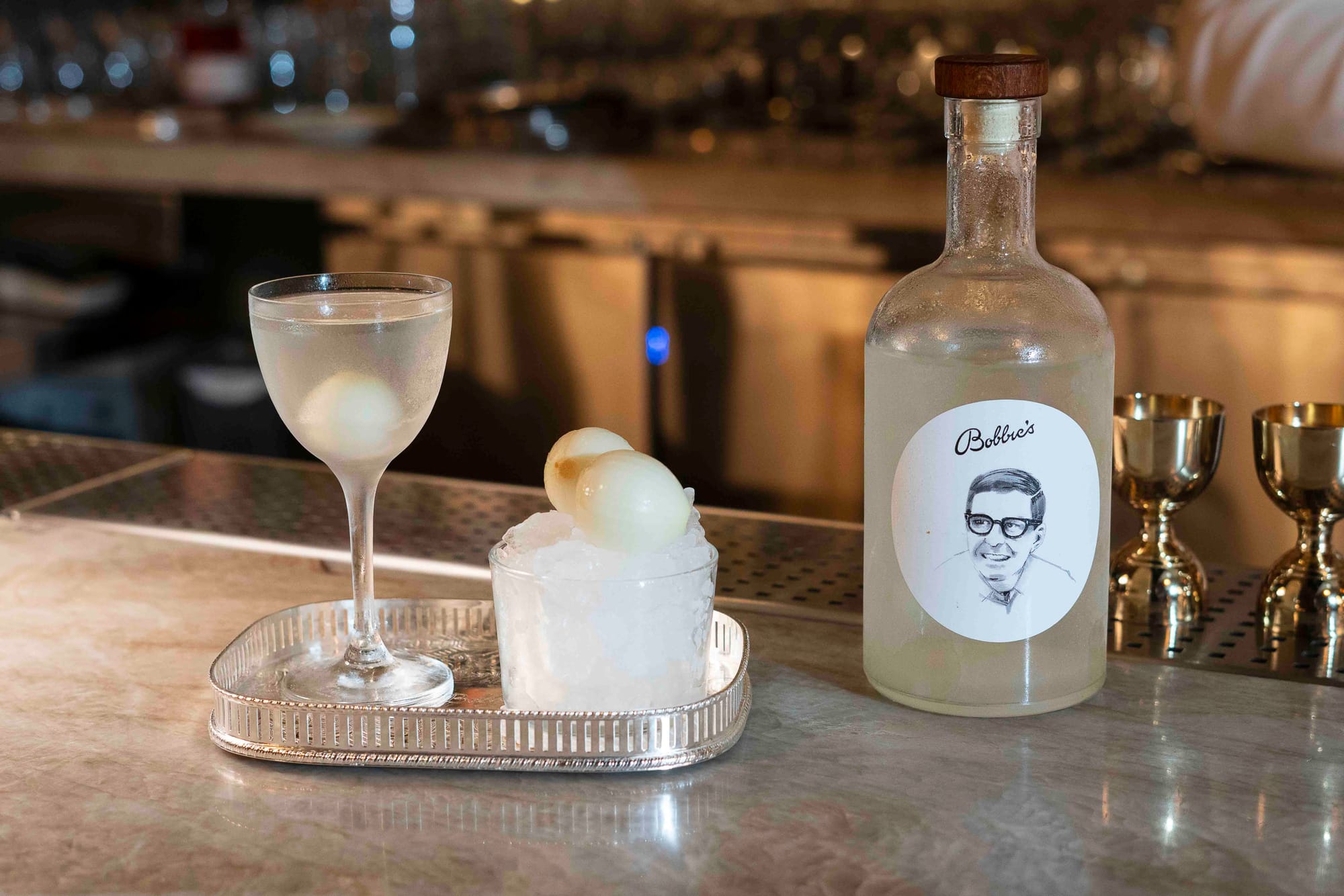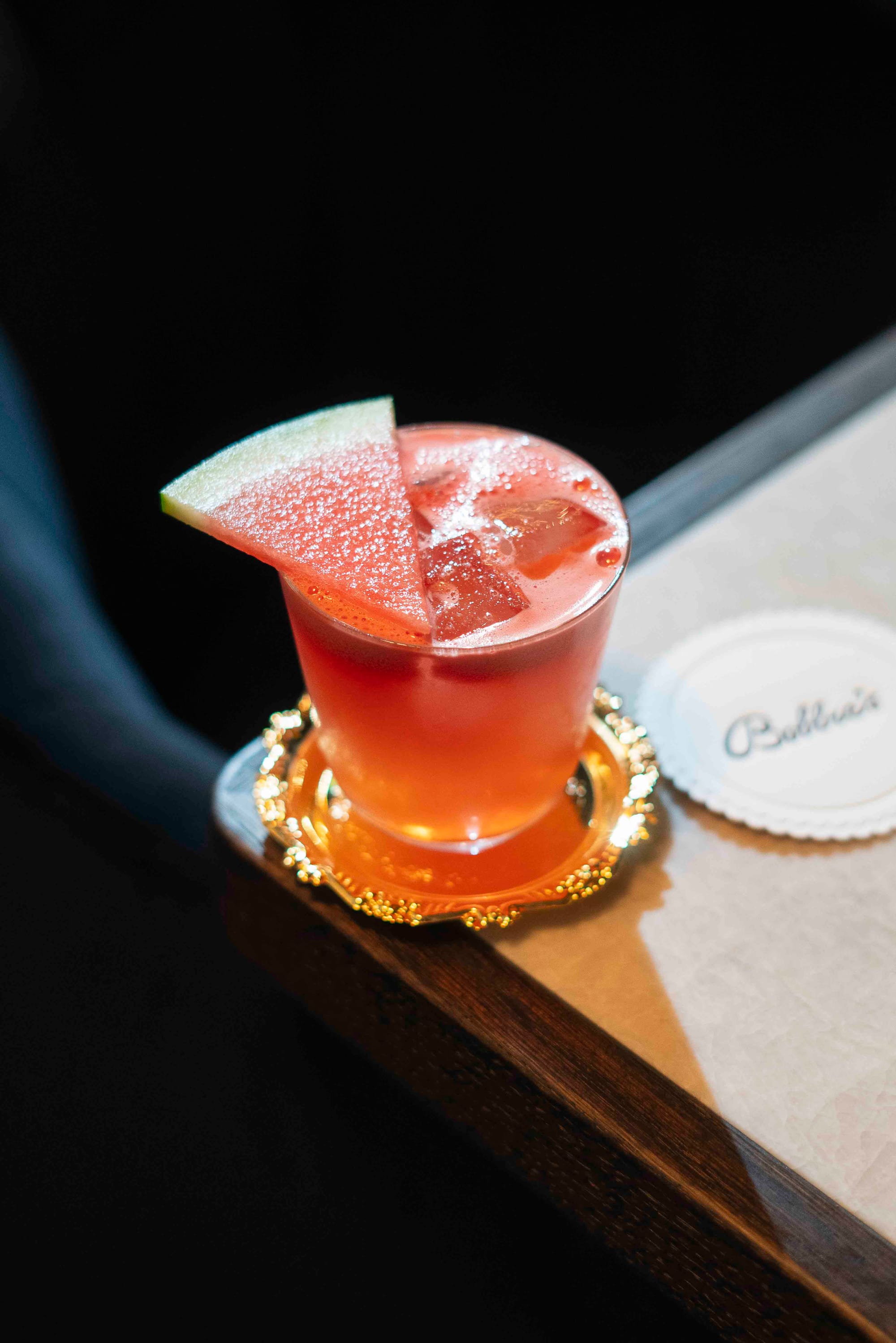Linden Pride on the Martini and aperitivo-led drinks list at Bobbie’s, Double Bay
The Dante NYC owner talks to us about his first Australian bar project in 15 years with Neil Perry.

Maybe you’ve noticed it, too. Over the last few years — particularly since the pandemic era reopening — cocktail menus have become smaller affairs, often focused around a tight eight or 10 drinks.
There was a time when much larger menus were what marked a cocktail bar as a serious bar — yes, you were expected to learn the specs for 50, 60, sometimes even 100 drinks. How many people really ever had them all down, I don’t know — I wasn’t one of them.
But whilst the era of 50-plus cocktail drinks lists is likely behind us (and honestly, how good can every drink on a list like that be?), cocktail menus are starting to get a little longer once again.
The latest entry into the Sydney market, Bobbie’s in Double Bay, makes a good case for a longer list.
Linden Pride talks Bobbie's, Double Bay. Video: Boothby
Bobbie’s opened at the end of August, in the basement below Neil Perry’s recently opened restaurant, Song Bird. The bar is a joint venture between Neil and Samantha Perry and Linden Pride and Nathalie Hudson, owners of Dante in New York and LA. You may have heard of Dante before; it’s the reason you make fluffy orange juice Garibaldis, and in 2019 was named the number one bar on The World’s 50 Best Bars.
Linden worked with Neil as his go to drinks guy back in the late 2000s, teeing up the drink programs for Rockpool Bar & Grill around Australia and The Waiting Room and more, and Bobbie’s — which is named for Linden’s grandfather, and Australia’s longest serving radio DJ, Bob Rogers OAM — is his first project back in Sydney for some 15 years.
The room is beautiful, with murals framing one wall, art deco touches, and a raised mezzanine and classy table seating — though if you ask me, the best spot to sit at is the bar. It’s also home to some very fine bar food — this is a Neil Perry place after all.
And there’s a big focus on cocktails — specifically, Martinis — at the bar. I stopped in recently to talk to Linden about the thinking behind the bar, how they’ve put together the smart drinks list (their Bobbie’s Martini and the Chandelier Martini were two of my favourites), ego behind the bar, consistency, and a whole lot more. Below, lightly edited and condensed for clarity, is my chat with Linden Pride.

Sam Bygrave: It’s a longer cocktail list than most lists we see these days.
Linden Pride: It’s about 24 drinks, and I wanted to break it up. Bobbie’s is a Martini and aperitivi bar — for me, Martini and aperitivi is kind of the same thing anyway. But there’s some places for people to land — I think when there’s a bigger menu, people know if they’re leaning towards a Martini style drink or something long and refreshing, or stirred down. And so we try to break it up like that so they can jump into different categories.
That way you’re not lost.
Yeah, exactly. My real focus is always twisted classics, trying to give the people what they want, I guess.
How’s it been so far? What’s the reception like?
It’s been great. I think we’re trying to define the experience a little bit as well. It’s a bar and we have a big cocktail menu, but we have a wonderful wine list as well. And there’s food and it’s not just any food, it’s Neil Perry’s small plates, so the food’s great.
Not bad bar food!
Yeah, not bad bar food. That’s what we should call it. We also have live bands and DJs with percussion and that kind of stuff, so there’s a lot. It’s just a matter of trying to understand what the experience is, and at what time of day the experience is, because we’re open at 2.30pm to 1am, and it’s a long stretch.
Why is that 2.30pm open important?
Because Song Bird and Margaret and the other restaurants in Double Bay dump 500 people on the street around that time after their first seating of lunch. And we want to give them somewhere to come. And besides The Sheaf and The Royal Oak, which are pubs, there’s nowhere serving late in the area.
I feel like I’m back in Sydney part-time hospitality, you know, Monday, Tuesday closed — we finished work on Sunday night and I felt like it was Christmas. In New York, we do breakfast, lunch, and dinner every day of the year and close only on Christmas. I was like wow, this is great because everyone gets a proper day off, you know, and they can actually lick their wounds.
But if like me you want to drink on Monday or Tuesday, then you know, the options are a little bit limited.
Yeah, I mean we’d like to get to seven days, seven nights, but I think during this kind of formative period, we’re going to start at five.
How many bartenders do you have behind the stick at any given time?
I have three bartenders working at any moment, two stations. And the drinks, we try to put a lot of work into the mise en place and batching the drinks; a 10 ingredient drink is just a two bottle pick up for example. Everything is fresh, I guess lot of bars are doing that now, but that’s really a program that we have had to really develop in New York. Caffe Dante is a 65 seat restaurant, and we’ll do six or seven hundred covers in a day. And we want to have a certain quality and level. A lot of people said to us, you’re taking the art out of bartending, because you’re not jiggering every 15mls — you know what? That’s fine. That’s a certain style of bartending I guess. For me I’d rather just get drinks in people’s hands in five minutes that are delicious and look great and are also consistent.
I’ve been working this industry for 25 years and there’s so much ego that’s in the bar, and I don’t really see that there’s a place for that, because it should be about the guest experience. So if they come in and Sam’s behind the bar or Linden’s behind the bar or Jimmy’s behind the bar, that amazing fluffy Margarita they love should always be the same.
How’s that ego thing changed over that 25 years? Do you think it’s gotten better or worse?
I think there’s so many amazingly creative, brilliant people in this industry, and we just try to work with them. That’s been the nicest thing about coming back and working with Neil to be honest. He’s such a hard worker and he leaves it all on the field, you know? And it’s not the hand of God telling you to do something. He’s in there with you, trying to fix it.
Where I think often that ego comes from is either somebody feeling like they’re not being supported, or that they’re worth more than the others or whatever. But if you’re all in it together, then there’s that camaraderie and that’s what is brilliant, that’s what hospitality is about.
What’s is like being back in Sydney again?
It’s amazing to come back to Sydney again, and work with the produce. Sydneysiders have such a high expectation or understanding of quality. There’s quality everywhere. Even coffee shops and that kind of thing — you have to do quality to survive down here. In New York, there’s so many more people, so generally speaking, the really great places are always full. And the not so great places also do okay because there’s a spillover effect. You can be busy seven nights of the week, packed.
[In Sydney] there’s slim pickings on Monday nights, but that’s also for a reason — there’s not a lot of people out and about on Mondays.
It was different before Covid, I think, it was getting to a place where it was almost a seven night a week city.
My gosh, let’s go back to that. Please.
You’ve got an extensive Martini menu. Tell us about that.
Yeah, definitely. So Bobbie’s drink was a Martini, and spending time with my grandfather at five o‘clock every day — from as young as I could remember — it was always cocktail hour and he’d always have a Martini at five o ‘clock, especially in the later years. We would always race to get around there at five o‘clock because it was great — there would be a game of Scrabble, and a Martini, or you’d be listening to music, and then we’d have dinner. And it was always the family home. My aunts and my mum, they all grew up in that house, and then as kids, we grew up in that house, and they still have the house. It was just this ritual. You come in the back gate and it’d be about the Martini.
So I wanted to do a big celebration of the Martini. It’s also one of my favourite drinks. There’s so many cool twists on it over the years, the top two-thirds of this menu is all spirit forward Martinis, twists on classics.
For the Bobbie’s, it’s a take on the Gibson. It’s batched, put in the freezer. So instead of, when you stir a Martini, you get that dilution of water — we estimate it to be like eight to 12 percent of the volume of the drink. But instead of doing that with water, we do it with clarified apple juice. It just gives it this little bit of acidity that matches with the two parts and the pickled onions. So you get this bright and incredibly complex Gibson that’s so refreshing.
The Chandelier Martini, that is a twist on the Alaska, We made this thing up called chandelier bitters, which is fun. The Tuxedo number three is a riff on the classic. But then we go into the nineties — I lived in London in the late nineties, early 2000s, when it was all about the fruity Martinis. And so we put a Lychee Martini on, a French martini on here as well.
There are some fun riffs on Negronis — we have a White Negroni, which is coconut, mango, and a pisco base. The classic Negroni, which is the Dante Negroni with a blend of vermouths, our three favourite red vermouths. In New York we call it the Last Sip — there’s so much talk about here, but the Last Sip Negroni is Antica Formula, Punt e Mes, and Martini Rubino. I did this with [chef] Massimo Bottura for his opening in Miami, and the idea of that drink was, when you first sip a Negroni it’s bitter and bracing and everything you wanted. It’s an acquired taste, but it’s usually that once it has sat on ice and the vermouth and the bitters have all blended with the gin, and it’s diluted, then you have that last sip, and you’re like, I’m going to have another one. That last sip of a Negroni is really important. And so we developed a drink that emulated that last sip and we used a big bold gin with grapefruit, which is Tanqueray Ten, and Antica and Punt e Mes being robust and Martini Rubino being kind of floral, and Campari. It captured that beautiful last sip flavour.

How long did this list take to put together?
We spent about two months in New York, and then a solid month here developing all the drinks new.
So none of these drinks are crossovers, nothing that in that long career of yours have come back out the pocket?
No, there’s a lot of technique, and a sensibility maybe. This is a different concept and experience, and we wanted it to be a little different in that way.
And I’m guessing every single juice has to be fluffy these days?
If you’re working in my world, yes. I had breakfast at my local cafe the other morning and I had an orange juice and it comes straight out of the Breville and I was like, you gotta brand this stuff — you might sell more orange juice.
Fluffy orange juice.
Makes all the difference. I was the bar manager at China Doll when we opened in 2004, we used to do fresh orange juice squeezed to order, and nobody else was doing it in a restaurant at that time. And it was so simple, but people just loved it.
You’ve got a genever drink on as well.
So my grandmother, she used to take me out to the theatre, which was a funny thing to do for a 15 year old boy, but maybe to try to educate me, she’d take me out to the Sydney Theatre Company, we’d have dinner beforehand in their little restaurant and that was the thing I loved the most — the theatre I wasn’t that interested in. I’d sit there and she would always have a Brandy Alexander, and I loved it. It tasted like a milkshake. So we did a Brandy Alexander, but with genever as the spirit and it’s so much lighter. You still get that little nuttiness and we fortify it with a bit of brandy and yeah, just crème fraîche, fresh nutmeg over the top. We call it Jerry’s Alexander — my grandmother’s name is Jerry.
I love that. What’s that like, being able put these family touches into a menu? Is it something you’ve done much before?
No, never. I mean, it was really inspired by Neil and Margaret, and I thought what a great testimonial. And my grandfather’s always been larger than life to me, and he inspired a lot of my reasons to move to New York. He spent a lot of time there when he was on tour with different artists because he used to broadcast. He used to tour with The Beatles and all these guys and he’d be like, you know, Bob Rogers on tour with The Beatles, reporting back. This is early television years so everyone would listen to the radio.
When he couldn’t travel anymore, when he was in his early nineties, he always said, New York, if he could go anywhere again, if he could just go back to the Bemelmans Bar in New York and listen to Woody Allen play the clarinet on Tuesday nights and drink a Martini, that’s where he’d go. There’s a lot of inspiration in here based on that line. There’s a mural on the wall, which is very Bemelmans. Live music, was a big part of what they do, and Martinis. There’s something so, for me, comforting about going to a place just like that.
And I think that that’s kind of what we created here. And Bobby was our muse, really, and he’s a legend. My grandmother really is the one that it should be probably named after because she’s the one who held the whole family together through all his shenanigans. But it’s nice, you know, and after being away for 15 years to come back home and to do something in the name of Bobbie and be able to bring my family in.

